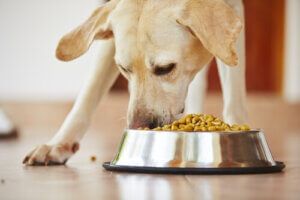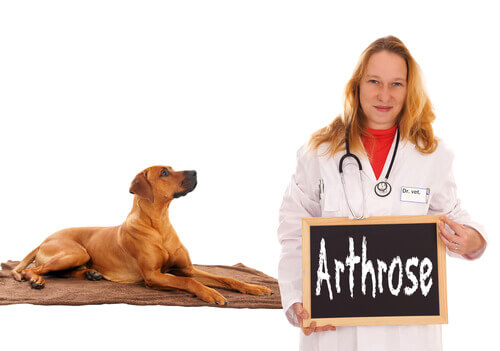The Best Food for Dogs with Arthrosis

What is arthrosis?
Just like humans, dogs can suffer from this degenerative disease that affects the joints in the body. Its symptoms worsen in the winter, which is when everything seems to become more rigid.
Joints are what join the bones of our body to one another, which move thanks to articular cartilage. This cartilage covers the joints and allows for mobility between the bones.

In the case of canine arthrosis, this cartilage ages and begins to fail, losing lubrication and becoming malnourished. As a result, pain develops when animals try to move. This illness is degenerative and has no cure. However, there are some ways to provide some relief from the symptoms.
How to know if your dog suffers from arthrosis
Even if your dog hasn’t received an official diagnosis of arthrosis, there are many signs that indicate that the disease may be in the beginning stages or in a more advanced state. Below are some of these signs:
- A dog doesn’t want to climb stairs. This may be one of the most painful actions for a dog with arthrosis to perform. That’s because the knees are the joints that suffer the most because they bear the animal’s weight. Climbing stairs requires a great effort so, in an attempt to avoid this pain, the dogs may refuse to do so.
- Getting up is difficult. If your pet has a hard time standing up or lying down, it may be because it’s beginning to have joint problems.
- Limping. A dog doesn’t have to limp all the time, but if you notice that an animal is limping more frequently, then this could be a sign of arthrosis.
- Loss of appetite. Like any other illness, when dogs have arthrosis, they also lose their appetite. That’s because the pain won’t even allow them to eat.

The best food for dogs with arthrosis
So, is it true that you can relieve your dog’s arthrosis pain through diet? Yes, you can. There is special food for treating the problems that this disease produces. At the same time, there are also ingredients that help to prevent canine arthrosis.
So, what is the best food for dogs with arthrosis? Let’s take a look.
- Food that contains essential ingredients for improving joint health. Remember that malnourished and aged cartilage is the cause of arthrosis and the pain it involves. So, what’s important is keeping your dog’s cartilage young and nourished for over. To do so, you can give your pet food that contains hyaluronic acid, glucosamine, and chondroitin sulfate.
- Calcium is another essential component in the fight against arthrosis. This mineral strengthens bones and, therefore, joints.
- Low-fat foods. Being overweight will only make arthrosis worse for animals. So, if you think your dog is starting to develop arthrosis, or already suffers from the disease, then you should opt for a diet that’s low in fat.
- Vitamin K2. This component will help protect your dog’s bones and cartilage.
- Magnesium will also be an ideal component in the best foods for dogs with arthrosis.
If your dog as arthrosis, then your veterinarian will provide the best advice regarding your pet’s diet. However, the above supplements should be present in the type of food you choose. That’s because they’re the components that will help relieve the pain and symptoms of arthrosis.
Furthermore, remember that there are things you can do at home to help your animal feel better. For example, you can put hot water bottles on your dog’s joints or offer gentle massages. And of course, lots of care and affection.
What is arthrosis?
Just like humans, dogs can suffer from this degenerative disease that affects the joints in the body. Its symptoms worsen in the winter, which is when everything seems to become more rigid.
Joints are what join the bones of our body to one another, which move thanks to articular cartilage. This cartilage covers the joints and allows for mobility between the bones.

In the case of canine arthrosis, this cartilage ages and begins to fail, losing lubrication and becoming malnourished. As a result, pain develops when animals try to move. This illness is degenerative and has no cure. However, there are some ways to provide some relief from the symptoms.
How to know if your dog suffers from arthrosis
Even if your dog hasn’t received an official diagnosis of arthrosis, there are many signs that indicate that the disease may be in the beginning stages or in a more advanced state. Below are some of these signs:
- A dog doesn’t want to climb stairs. This may be one of the most painful actions for a dog with arthrosis to perform. That’s because the knees are the joints that suffer the most because they bear the animal’s weight. Climbing stairs requires a great effort so, in an attempt to avoid this pain, the dogs may refuse to do so.
- Getting up is difficult. If your pet has a hard time standing up or lying down, it may be because it’s beginning to have joint problems.
- Limping. A dog doesn’t have to limp all the time, but if you notice that an animal is limping more frequently, then this could be a sign of arthrosis.
- Loss of appetite. Like any other illness, when dogs have arthrosis, they also lose their appetite. That’s because the pain won’t even allow them to eat.

The best food for dogs with arthrosis
So, is it true that you can relieve your dog’s arthrosis pain through diet? Yes, you can. There is special food for treating the problems that this disease produces. At the same time, there are also ingredients that help to prevent canine arthrosis.
So, what is the best food for dogs with arthrosis? Let’s take a look.
- Food that contains essential ingredients for improving joint health. Remember that malnourished and aged cartilage is the cause of arthrosis and the pain it involves. So, what’s important is keeping your dog’s cartilage young and nourished for over. To do so, you can give your pet food that contains hyaluronic acid, glucosamine, and chondroitin sulfate.
- Calcium is another essential component in the fight against arthrosis. This mineral strengthens bones and, therefore, joints.
- Low-fat foods. Being overweight will only make arthrosis worse for animals. So, if you think your dog is starting to develop arthrosis, or already suffers from the disease, then you should opt for a diet that’s low in fat.
- Vitamin K2. This component will help protect your dog’s bones and cartilage.
- Magnesium will also be an ideal component in the best foods for dogs with arthrosis.
If your dog as arthrosis, then your veterinarian will provide the best advice regarding your pet’s diet. However, the above supplements should be present in the type of food you choose. That’s because they’re the components that will help relieve the pain and symptoms of arthrosis.
Furthermore, remember that there are things you can do at home to help your animal feel better. For example, you can put hot water bottles on your dog’s joints or offer gentle massages. And of course, lots of care and affection.
This text is provided for informational purposes only and does not replace consultation with a professional. If in doubt, consult your specialist.








